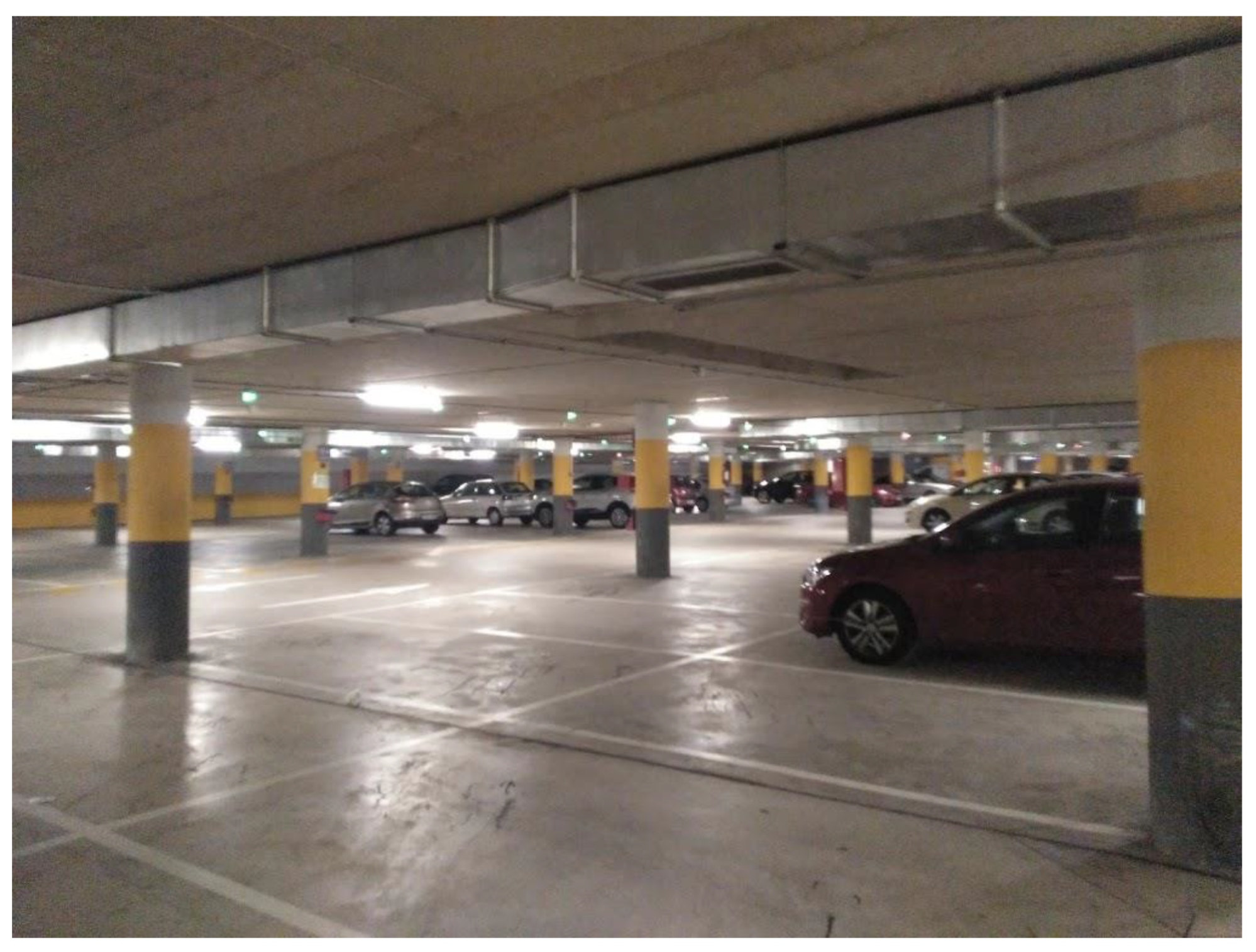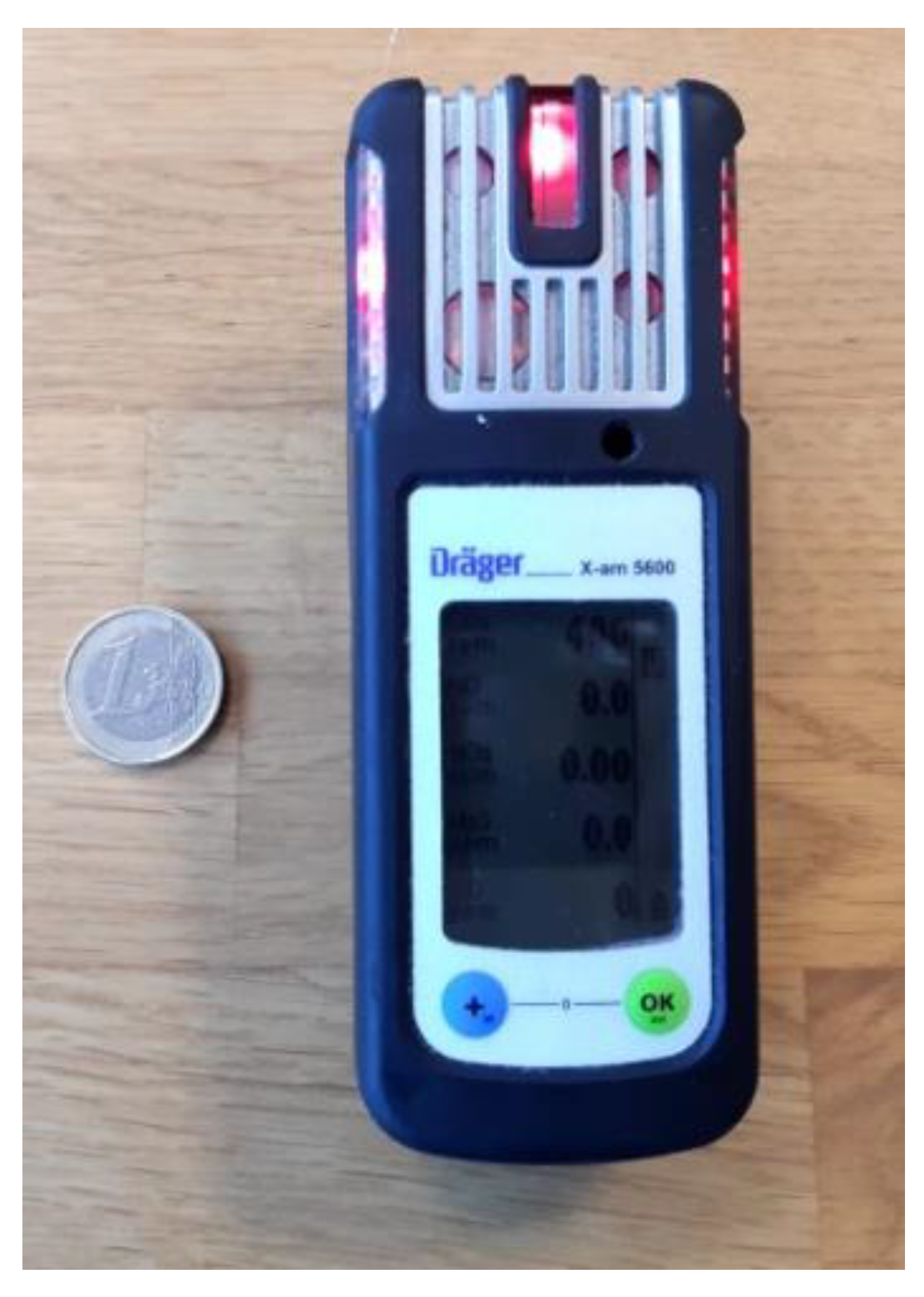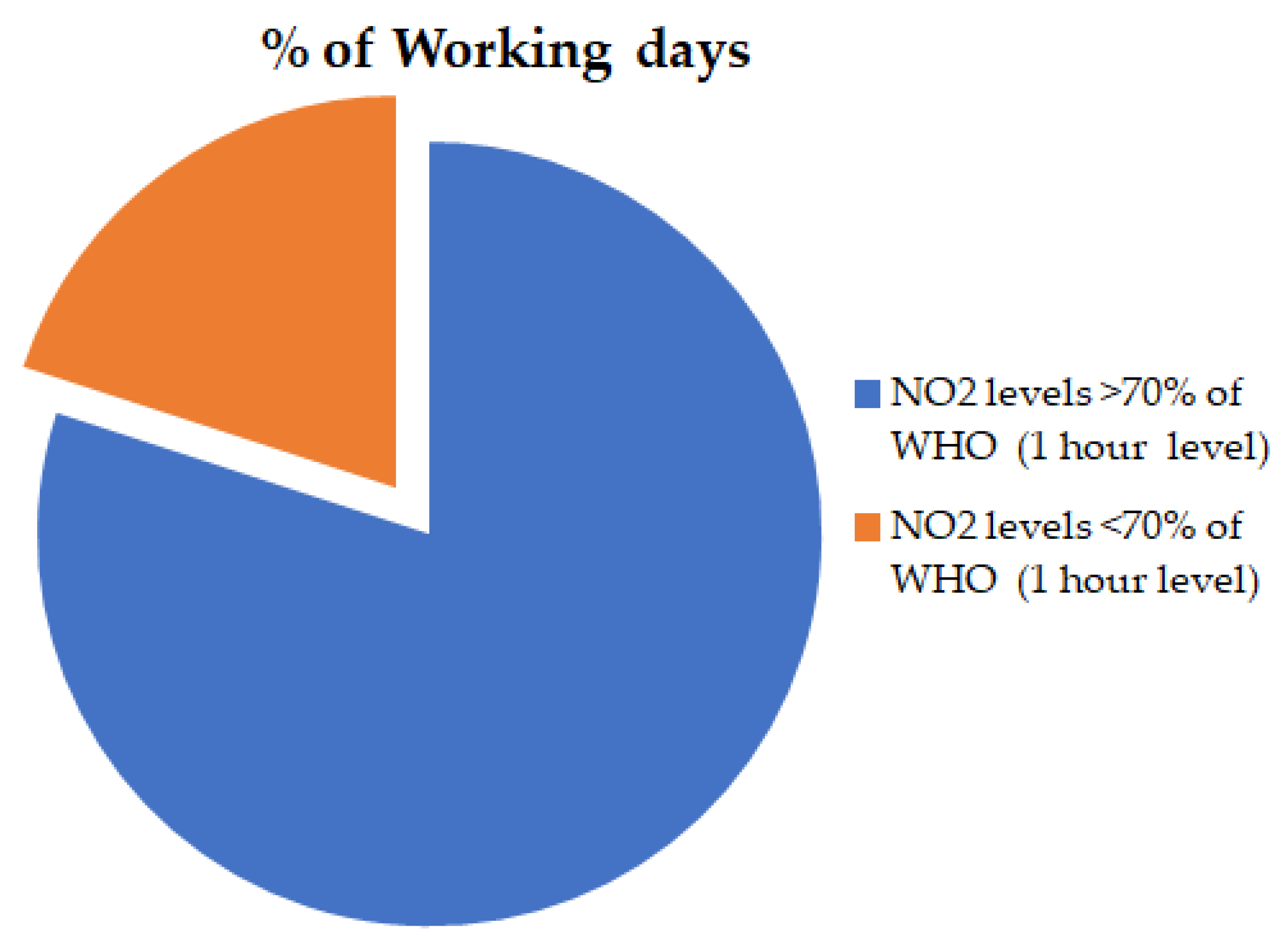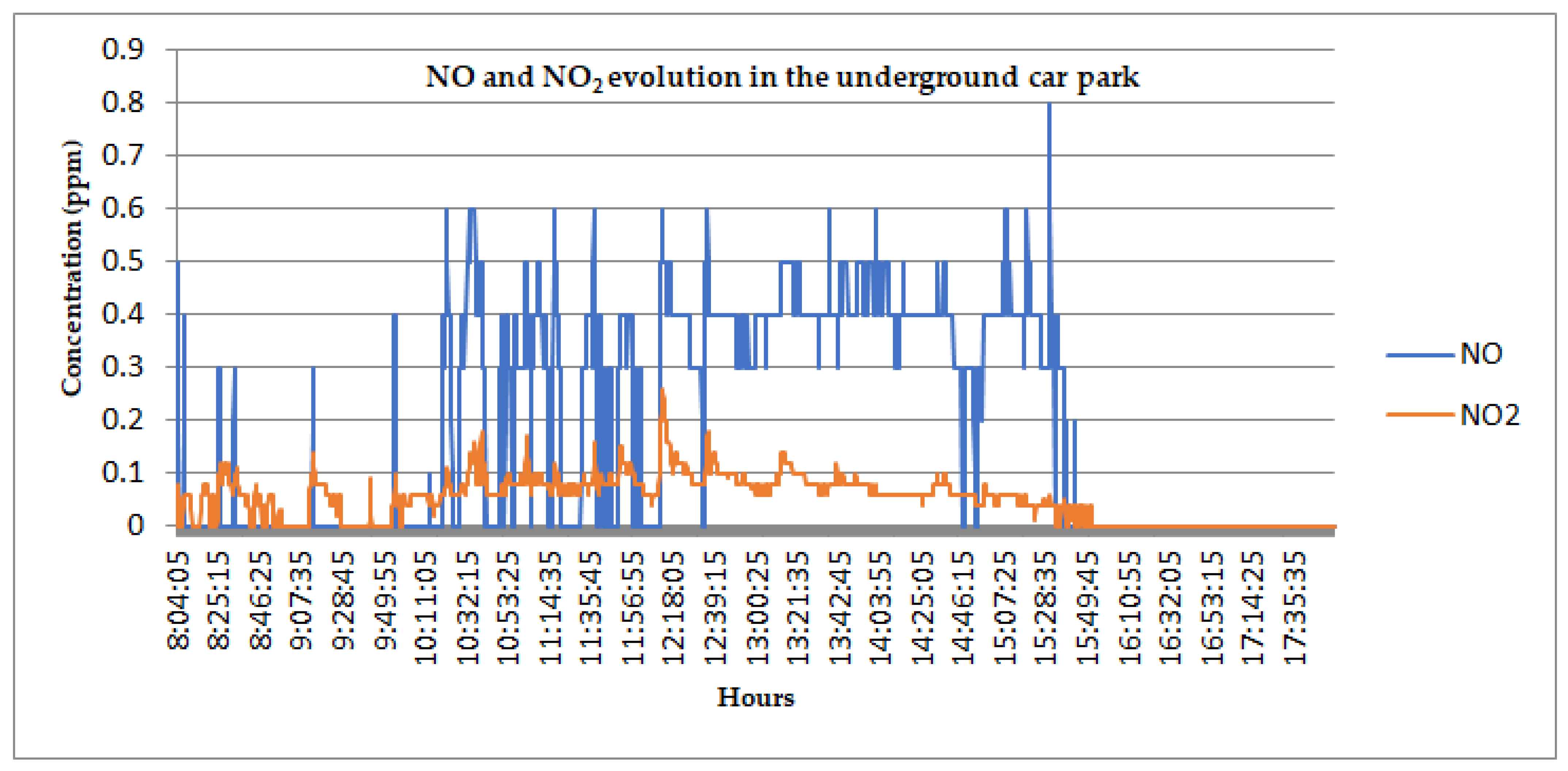Assessment of NOx Levels in an Underground Hospital Car Park: Implications for Occupational and Environmental Health
Abstract
1. Introduction
2. Materials and Methods
2.1. Parking Description
2.2. Sample Design
2.3. Limits
3. Results
4. Discussion
5. Conclusions
Author Contributions
Funding
Institutional Review Board Statement
Informed Consent Statement
Data Availability Statement
Acknowledgments
Conflicts of Interest
References
- Belch, J.J.; Fitton, C.; Cox, B.; Chalmers, J.D. Associations between Ambient Air Pollutants and Hospital Admissions: More Needs to Be Done. Environ. Sci. Pollut. Res. Int. 2021, 28, 61848–61852. [Google Scholar] [CrossRef]
- Ab Manan, N.; Noor Aizuddin, A.; Hod, R. Effect of Air Pollution and Hospital Admission: A Systematic Review. Ann. Glob. Health 2018, 84, 670–678. [Google Scholar] [CrossRef]
- Meng, Y.-Y.; Yue, D.; Molitor, J.; Chen, X.; Su, J.G.; Jerrett, M. Reductions in NO2 and Emergency Room Visits Associated with California’s Goods Movement Policies: A Quasi-Experimental Study. Environ. Res. 2022, 213, 113600. [Google Scholar] [CrossRef]
- César, A.C.G.; Carvalho, J.A.; Nascimento, L.F.C. Association between NOx Exposure and Deaths Caused by Respiratory Diseases in a Medium-Sized Brazilian City. Braz. J. Med. Biol. Res. 2015, 48, 1130–1135. [Google Scholar] [CrossRef] [PubMed]
- Zhang, J.; Wei, Y.; Fang, Z. Ozone Pollution: A Major Health Hazard Worldwide. Front. Immunol. 2019, 10, 2518. [Google Scholar] [CrossRef] [PubMed]
- Wecker, H.; Tizek, L.; Ziehfreund, S.; Kain, A.; Traidl-Hoffmann, C.; Zimmermann, G.S.; Scala, E.; Elberling, J.; Doll, A.; Boffa, M.J.; et al. Impact of Asthma in Europe: A Comparison of Web Search Data in 21 European Countries. World Allergy Organ. J. 2023, 16, 100805. [Google Scholar] [CrossRef] [PubMed]
- Schreibman, A.; Xie, S.; Hubbard, R.A.; Himes, B.E. Linking Ambient NO2 Pollution Measures with Electronic Health Record Data to Study Asthma Exacerbations. AMIA Jt. Summits Transl. Sci. Proc. 2023, 2023, 467–476. [Google Scholar] [PubMed]
- Anenberg, S.C.; Mohegh, A.; Goldberg, D.L.; Kerr, G.H.; Brauer, M.; Burkart, K.; Hystad, P.; Larkin, A.; Wozniak, S.; Lamsal, L. Long-Term Trends in Urban NO2 Concentrations and Associated Paediatric Asthma Incidence: Estimates from Global Datasets. Lancet Planet. Health 2022, 6, e49–e58. [Google Scholar] [CrossRef] [PubMed]
- Lagorio, S.; Forastiere, F.; Pistelli, R.; Iavaronem, I.; Ostro, B.D.; Michelozzi, P.; Fano, V. Air Pollution and Lung Function among Susceptible Adult Subjects: A Panel Study. Epidemiology 2004, 15, S45–S46. [Google Scholar] [CrossRef][Green Version]
- Chauhan, A.J.; Inskip, H.M.; Linaker, C.H.; Smith, S.; Schreiber, J.; Johnston, S.L.; Holgate, S.T. Personal Exposure to Nitrogen Dioxide (NO2) and the Severity of Virus-Induced Asthma in Children. Lancet 2003, 361, 1939–1944. [Google Scholar] [CrossRef] [PubMed]
- Belanger, K.; Gent, J.F.; Triche, E.W.; Bracken, M.B.; Leaderer, B.P. Association of Indoor Nitrogen Dioxide Exposure with Respiratory Symptoms in Children with Asthma. Am. J. Respir. Crit. Care Med. 2006, 173, 297–303. [Google Scholar] [CrossRef] [PubMed]
- Taj, T.; Stroh, E.; Åström, D.O.; Jakobsson, K.; Oudin, A. Short-Term Fluctuations in Air Pollution and Asthma in Scania, Sweden. Is the Association Modified by Long-Term Concentrations? PLoS ONE 2016, 11, e0166614. [Google Scholar] [CrossRef] [PubMed]
- Nordling, E.; Berglind, N.; Melén, E.; Emenius, G.; Hallberg, J.; Nyberg, F.; Pershagen, G.; Svartengren, M.; Wickman, M.; Bellander, T. Traffic-Related Air Pollution and Childhood Respiratory Symptoms, Function and Allergies. Epidemiology 2008, 19, 401–408. [Google Scholar] [CrossRef]
- Melén, E.; Nyberg, F.; Lindgren, C.M.; Berglind, N.; Zucchelli, M.; Nordling, E.; Hallberg, J.; Svartengren, M.; Morgenstern, R.; Kere, J.; et al. Interactions between Glutathione S-Transferase P1, Tumor Necrosis Factor, and Traffic-Related Air Pollution for Development of Childhood Allergic Disease. Environ. Health Perspect. 2008, 116, 1077–1084. [Google Scholar] [CrossRef] [PubMed]
- Hao, H.; Eckel, S.P.; Hosseini, A.; Van Vliet, E.D.S.; Dzubur, E.; Dunton, G.; Chang, S.Y.; Craig, K.; Rocchio, R.; Bastain, T.; et al. Daily Associations of Air Pollution and Pediatric Asthma Risk Using the Biomedical REAI-Time Health Evaluation (BREATHE) Kit. Int. J. Environ. Res. Public. Health 2022, 19, 3578. [Google Scholar] [CrossRef] [PubMed]
- Gillespie-Bennett, J.; Pierse, N.; Wickens, K.; Crane, J.; Howden-Chapman, P.; The Housing Heating and Health Study Research Team. The Respiratory Health Effects of Nitrogen Dioxide in Children with Asthma. Eur. Respir. J. 2011, 38, 303–309. [Google Scholar] [CrossRef] [PubMed]
- Al-Mutairi, N.Z.; Almutairi, T.; Matar, H.B. Concentration of Carbon Monoxide in an Enclosed Parking Garage. Am. J. Eng. Appl. Sci. 2020, 13, 402–408. [Google Scholar] [CrossRef]
- Demir, A. Investigation of Air Quality in the Underground and Aboveground Multi-Storey Car Parks in Terms of Exhaust Emissions. Procedia Soc. Behav. Sci. 2015, 195, 2601–2611. [Google Scholar] [CrossRef][Green Version]
- Mohammed, I.; Othman, N.; Baharuddin, K. Air Quality Profile in an Enclosed Car Park. Appl. Mech. Mater. 2014, 567, 3–7. [Google Scholar] [CrossRef]
- Croeser, T.; Garrard, G.E.; Visintin, C.; Kirk, H.; Ossola, A.; Furlong, C.; Clements, R.; Butt, A.; Taylor, E.; Bekessy, S.A. Finding Space for Nature in Cities: The Considerable Potential of Redundant Car Parking. npj Urban Sustain. 2022, 2, 27. [Google Scholar] [CrossRef]
- Godard, J.-P. Underground Car Parks: International Case Studies: ITA Working Group No. 13, “Direct and Indirect Advantages of Underground Structures”. Tunn. Undergr. Space Technol. 1995, 10, 321–342. [Google Scholar] [CrossRef]
- Jonson, J.E.; Borken-Kleefeld, J.; Simpson, D.; Nyíri, A.; Posch, M.; Heyes, C. Impact of Excess NOx Emissions from Diesel Cars on Air Quality, Public Health and Eutrophication in Europe. Environ. Res. Lett. 2017, 12, 094017. [Google Scholar] [CrossRef]
- Mulholland, E.; Miller, J.; Bernard, Y.; Lee, K.; Rodriguez, F. The Role of NOx Emission Reductions in Euro 7/VII Vehicle Emission Standards to Reduce Adverse Health Impacts in the EU27 through 2050. Transp. Eng. 2022, 9, 100133. [Google Scholar] [CrossRef]
- Committee on Acute Exposure Guideline Levels. Acute Exposure Guideline Levels for Selected Airborne Chemicals; The National Academies Press: Washington, DC, USA, 2012; ISBN 978-0-309-25481-6. [Google Scholar]
- Hesterberg, T.W.; Bunn, W.B.; McClellan, R.O.; Hamade, A.K.; Long, C.M.; Valberg, P.A. Critical Review of the Human Data on Short-Term Nitrogen Dioxide (NO2) Exposures: Evidence for NO2 No-Effect Levels. Crit. Rev. Toxicol. 2009, 39, 743–781. [Google Scholar] [CrossRef] [PubMed]
- Lopatin, O.P. Phenomenology of Nitrogen Oxides Formation in a Gas-Diesel Engine. J. Phys. Conf. Ser. 2020, 1515, 042009. [Google Scholar] [CrossRef]
- Singh, A.; Bartington, S.E.; Song, C.; Ghaffarpasand, O.; Kraftl, M.; Shi, Z.; Pope, F.D.; Stacey, B.; Hall, J.; Thomas, G.N.; et al. Impacts of Emergency Health Protection Measures upon Air Quality, Traffic and Public Health: Evidence from Oxford, UK. Environ. Pollut. 2022, 293, 118584. [Google Scholar] [CrossRef]
- Nieuwenhuijsen, M.J.; Khreis, H. Car Free Cities: Pathway to Healthy Urban Living. Environ. Int. 2016, 94, 251–262. [Google Scholar] [CrossRef]
- Kelly, F.; Anderson, H.R.; Armstrong, B.; Atkinson, R.; Barratt, B.; Beevers, S.; Derwent, D.; Green, D.; Mudway, I.; Wilkinson, P.; et al. The Impact of the Congestion Charging Scheme on Air Quality in London. Part 1. Emissions Modeling and Analysis of Air Pollution Measurements. Res. Rep. Health Eff. Inst. 2011, 155, 5–71. [Google Scholar]
- Carslaw, D.; Farren, N.; Vaughan, A.; Drysdale, W.; Young, S.; Lee, J. The Diminishing Importance of Nitrogen Dioxide Emissions from Road Vehicle Exhaust. Atmos. Environ. X 2018, 1, 100002. [Google Scholar] [CrossRef]
- Garcia-Gonzalez, H.; Rodriguez, R.; Bascompta, M. Nitrogen Dioxide Gas Levels in TBM Tunnel Construction with Diesel Locomotives Based on Directive 2017/164/EU. Appl. Sci. 2023, 13, 10551. [Google Scholar] [CrossRef]
- WHO. Air Quality Guidelines for Europe, 2nd ed.; WHO: Copenhagen, Denmark, 2000; Volume 91, ISBN 92-890-1358-3.
- Khomenko, S.; Cirach, M.; Pereira-Barboza, E.; Mueller, N.; Barrera-Gómez, J.; Rojas-Rueda, D.; de Hoogh, K.; Hoek, G.; Nieuwenhuijsen, M. Premature Mortality Due to Air Pollution in European Cities: A Health Impact Assessment. Lancet Planet. Health 2021, 5, e121–e134. [Google Scholar] [CrossRef]
- Garcia-Gonzalez, H.; Domat, M.; Lopez-Pola, T.; Fernandez-Rubio, P.; Fernandez-Rodriguez, P. Particulate Matter Characterization in a Hospital’s Underground Car Park. Powders 2022, 1, 194–206. [Google Scholar] [CrossRef]
- Smederup Hansen, D.; Rodica Ilisescur, A.; Madesn, P.G.; Clark, D. Supporting the Fitness Check of the EU Ambient Air Quality Directives (2008/50/EC, 2004/107/EC); Unit C.3-Clean Air; European Commission: Brussels, Belgium, 2019. [Google Scholar]
- Efremenko, A.Y.; Seagrave, J.; Clewell, H.J.; Van Landingham, C.; Gentry, P.R.; Yager, J.W. Evaluation of Gene Expression Changes in Human Primary Lung Epithelial Cells Following 24-Hr Exposures to Inorganic Arsenic and Its Methylated Metabolites and to Arsenic Trioxide. Environ. Mol. Mutagen. 2015, 56, 477–490. [Google Scholar] [CrossRef]
- Wang, X.; Song, G.; Wu, Y.; Yu, L.; Zhai, Z. A NOx Emission Model Incorporating Temperature for Heavy-Duty Diesel Vehicles with Urea-SCR Systems Based on Field Operating Modes. Atmosphere 2019, 10, 337. [Google Scholar] [CrossRef]
- García González, H.; González, J.; González Cachón Fernández, S.; Pellicer Mateos, S. Nitrogen Oxides Gas Levels in NATM Tunnel Construction during the Directive 2017/164/EU Transitional Period. Inf. De La Construcción 2022, 74, 2. [Google Scholar]
- Douglas, W.W.; Hepper, N.G.; Colby, T.V. Silo-Filler’s Disease. Mayo Clin. Proc. 1989, 64, 291–304. [Google Scholar] [CrossRef] [PubMed]
- Heberle, S.M.; Lorini, C.; Rosa, M.S.G.; Barros, N. Evaluation of Bus Driver Exposure to Nitrogen Dioxide Levels during Working Hours. Atmos. Environ. 2019, 216, 116906. [Google Scholar] [CrossRef]
- Kerr, H.D.; Kulle, T.J.; McIlhany, M.L.; Swidersky, P. Effects of Nitrogen Dioxide on Pulmonary Function in Human Subjects: An Environmental Chamber Study. Environ. Res. 1979, 19, 392–404. [Google Scholar] [CrossRef] [PubMed]
- U.S. EPA. Guidelines for Exposure Assessment; EPA/600/Z-92/001; U.S. Environmental Protection Agency: Washington, DC, USA, 1992.
- Garcia Gonzalez, H.; García-Ordiales, E.; Diez, R.R. Analysis of the Airborne Mercury and Particulate Arsenic Levels Close to an Abandoned Waste Dump and Buildings of a Mercury Mine and the Potential Risk of Atmospheric Pollution. SN Appl. Sci. 2022, 4, 76. [Google Scholar] [CrossRef]
- Nagl, C.; Spangl, W.; Buxbaum, I. Sampling Points for Air Quality: Representativeness and Comparability of Measurement in Accordance with Directive 2008/50/EC on Ambient Air Quality and Cleaner Air for Europe; European Parliament: Luxembourg, 2019. [Google Scholar]
- Rodríguez, R.; Garcia-Gonzalez, H.; Pastrana, Á.; Hernández, Z. Health and Safety Protocol for the Management of Building Demolition Waste with High Mercury Contamination. Buildings 2023, 13, 1310. [Google Scholar] [CrossRef]
- EN 689:2019 + AC:2019; Workplace Exposure—Measurement of Exposure by Inhalation to Chemical Agents—Strategy for Testing Compliance with Occupational Exposure Limit Values. European Standards UNE: Pilsen, Czech Republic, 2019.
- Límites de Exposición Profesional para Agentes Químicos 2022—Portal INSST-INSST. Available online: https://www.insst.es/documentacion/catalogo-de-Publicaciones/limites-de-exposicion-profesional-para-agentes-quimicos-2022 (accessed on 26 January 2023).
- GESTIS International Limit Values. Available online: https://limitvalue.ifa.dguv.de/ (accessed on 29 December 2023).
- Nitrogen Dioxide—Annual Limit Values for the Protection of Human Health—European Environment Agency. Available online: https://www.eea.europa.eu/data-and-maps/figures/nitrogen-dioxide-annual-limit-values-for-the-protection-of-human-health (accessed on 7 April 2021).
- World Health Organization. WHO Global Air Quality Guidelines: Particulate Matter (PM2.5 and PM10), Ozone, Nitrogen Dioxide, Sulfur Dioxide and Carbon Monoxide; World Health Organization: Geneva, Switzerland, 2021; ISBN 978-92-4-003422-8.
- Koehler, C.; Paulus, M.; Ginzkey, C.; Hackenberg, S.; Scherzad, A.; Ickrath, P.; Hagen, R.; Kleinsasser, N. The Proinflammatory Potential of Nitrogen Dioxide and Its Influence on the House Dust Mite Allergen Der p 1. Int. Arch. Allergy Immunol. 2016, 171, 27–35. [Google Scholar] [CrossRef] [PubMed]
- Government of the Principality of Asturias. Air Quality in Asturias 2021; Government of the Principality of Asturias: Oviedo, Spain, 2022.




| NO2 | NO | |||||||
|---|---|---|---|---|---|---|---|---|
| Limit Value—8 h | Limit Value—Short Term | Limit Value—8 h | Limit Value—Short Term | |||||
| ppm | mg/m³ | ppm | mg/m³ | ppm | mg/m³ | ppm | mg/m³ | |
| Australia | 3 | 5.6 | 5 | 9.4 | 25 | 31 | ||
| Austria | 0.5 | 0.96 | 1 | 1.91 | 2 | 2.5 | ||
| Belgium | 0.5 | 0.96 | 1 | 1.91 | 2 | 2.5 | ||
| Canada-Ontario | 3 | 5 | 25 | |||||
| Canada-Québec | 3 | 5.6 | 5 | 9.4 | 25 | 31 | ||
| Denmark | 0.5 | 0.96 | 2 | 4 | 2 | 2.5 | 4 | 5 |
| European Union | 0.5 | 0.96 | 1 | 1.91 | 2 | 2.5 | ||
| Finland | 0.5 | 0.96 | 1 | 1.9 | 2 | 2.5 | ||
| France | 0.5 | 0.96 | 1 | 1.91 | 2 | 2.5 | ||
| Germany (AGS) | 0.5 | 0.95 | 1 | 1.9 | 2 | 2.5 | 4 | 5 |
| Germany (DFG) | 0.5 | 0.95 | 0.5 | 0.95 | 0.5 | 0.63 | 1.0 | 1.26 |
| Hungary | 0.96 | 1.91 | 2.5 | |||||
| Ireland | 3 | 5 | 5 | 9 | 25 | 30 | 35 | 45 |
| Italy | 0.5 | 0.96 | 1 | 1.91 | 2 | 2.5 | ||
| Latvia | 0.5 | 0.96 | 1 | 1.91 | 2 | 2.5 | ||
| New Zealand | 3 | 5.6 | 5 | 9.4 | 25 | 31 | ||
| Norway | 0.5 | 0.96 | 1 | 1.91 | 2 | 2.5 | ||
| China | 5 | 10 | 15 | |||||
| Poland | 0.7 | 1.5 | 2.5 | |||||
| Romania | 0.5 | 0.96 | 1 | 1.91 | 2 | 2.5 | ||
| Singapore | 3 | 5.6 | 5 | 9.4 | 25 | 31 | ||
| South Africa | 0.4 | 50 | ||||||
| South Africa Mining | 3 | 5 | 5 | 9 | 25 | 30 | 35 | 45 |
| South Korea | 3 | 5 | 25 | |||||
| Spain | 0.5 | 0.96 | 1 | 1.91 | 2 | 2.5 | ||
| Sweden | 0.5 | 0.96 | 1 | 1.9 | 2 | 2.5 | ||
| Switzerland | 1.5 | 3 | 3 | 6 | 5 | 6 | ||
| The Netherlands | 0.5 | 0.96 | 1 | 1.91 | 2 | 2.5 | ||
| USA-NIOSH | 1 | 1.8 | 25 | 30 | ||||
| USA-OSHA | 5 | 9 | 25 | 30 | ||||
| United Kingdom | 0.5 | 0.9 | 1 | 1.91 | 25 | 30 | ||
| Underground Car Park | Outdoor | |||||||||||||
|---|---|---|---|---|---|---|---|---|---|---|---|---|---|---|
| NO | NO2 | NO | NO2 | |||||||||||
| nº | Date | Nº Vehicles | Start | Finish | Hours | Average (ppm) | Max (ppm) | Standard Deviation (σ) | Average (ppm) | Max (ppm) | Max (1 h Average) (ppm) | Standard Deviation (σ) | Max (1 h Average) (ppm) | |
| 1 | 18/07/2019 | 1614 | 8:32 | 19:08 | 10:36 | 0.045 | 0.60 | 0.113 | 0.039 | 0.58 | 0.095 | 0.050 | 0.022 | 0.016 |
| 2 | 19/07/2019 | 1481 | 7:46 | 13:46 | 6:00 | 0.201 | 1.00 | 0.194 | 0.097 | 0.62 | 0.165 | 0.060 | 0.014 | 0.019 |
| 3 | 15/02/2021 | 1552 | 7:49 | 15:36 | 7:47 | 0.354 | 1.30 | 0.194 | 0.047 | 0.45 | 0.083 | 0.043 | 0.123 | 0.041 |
| 4 | 16/02/2021 | 1590 | 8:00 | 16:24 | 8:24 | 0.087 | 0.80 | 0.155 | 0.033 | 0.25 | 0.083 | 0.037 | 0.053 | 0.038 |
| 5 | 17/02/2021 | 1618 | 7:51 | 16:48 | 8:57 | 0.117 | 1.10 | 0.201 | 0.037 | 0.14 | 0.072 | 0.033 | 0.069 | 0.036 |
| 6 | 08/04/2021 | 1640 | 7:36 | 17:59 | 10:23 | 0.124 | 1.50 | 0.203 | 0.009 | 0.31 | 0.033 | 0.022 | 0.056 | 0.030 |
| 7 | 09/04/2021 | 1600 | 7:34 | 16:50 | 9:16 | 0.246 | 3.50 | 0.244 | 0.0167 | 0.14 | 0.075 | 0.029 | 0.080 | 0.038 |
| 8 | 15/04/2021 | 1605 | 7:51 | 15:42 | 7:51 | 0.023 | 1.00 | 0.091 | 0.03 | 0.18 | 0.064 | 0.032 | 0.052 | 0.040 |
| 9 | 07/09/2021 | 1484 | 8:52 | 13:01 | 4:09 | 0.196 | 7.3 | 0.326 | 0.026 | 1.17 | 0.074 | 0.076 | 0.054 | 0.038 |
| 10 | 15/09/2021 | 1679 | 7:49 | 18:22 | 10:33 | 0.0811 | 1.6 | 0.172 | 0.032 | 0.51 | 0.100 | 0.048 | 0.026 | 0.028 |
| 11 | 16/09/2021 | 1662 | 8:07 | 17:48 | 9:41 | 0.1268 | 0.8 | 0.190 | 0.022 | 0.36 | 0.087 | 0.042 | 0.018 | 0.022 |
| 12 | 17/09/2021 | 1618 | 7:54 | 14:48 | 6:54 | 0.13 | 1 | 0.170 | 0.042 | 0.24 | 0.072 | 0.034 | 0.027 | 0.023 |
| 13 | 28/09/2021 | 1654 | 8:03 | 17:56 | 10:53 | 0.182 | 0.8 | 0.202 | 0.052 | 0.26 | 0.107 | 0.036 | 0.037 | 0.029 |
| 14 | 30/09/2021 | 1642 | 8:03 | 14:32 | 6:29 | 0.176 | 1.7 | 0.211 | 0.046 | 0.32 | 0.098 | 0.048 | 0.066 | 0.030 |
| NO | NO2 | |||||||||
|---|---|---|---|---|---|---|---|---|---|---|
| nº | Date | City | Start | Finish | h | Average (ppm) | Max (ppm) | Average (ppm) | Max (ppm) | Max (1 h Average) (ppm) |
| 1 | 21/11/2023 | Salamanca P-2 | 7:30 | 16:20 | 8:50 | 0.03 | 0.7 | 0.02 | 0.18 | 0.039 |
| 2 | 21/11/2023 | Salamanca P-1 | 7:56 | 16:41 | 8:45 | 0.08 | 0.8 | 0.06 | 0.2 | 0.085 |
| 3 | 27/04/2023 | Aviles P-2 | 7:36 | 14:27 | 6:51 | 0.47 | 1.8 | 0 | 0.11 | 0.001 |
| 4 | 27/04/2023 | Aviles P-3 | 7:48 | 14:21 | 6:33 | 0.6 | 1.8 | 0.01 | 0.1 | 0.03 |
Disclaimer/Publisher’s Note: The statements, opinions and data contained in all publications are solely those of the individual author(s) and contributor(s) and not of MDPI and/or the editor(s). MDPI and/or the editor(s) disclaim responsibility for any injury to people or property resulting from any ideas, methods, instructions or products referred to in the content. |
© 2024 by the authors. Licensee MDPI, Basel, Switzerland. This article is an open access article distributed under the terms and conditions of the Creative Commons Attribution (CC BY) license (https://creativecommons.org/licenses/by/4.0/).
Share and Cite
Garcia-Gonzalez, H.; Lopez-Pola, T.; Martinez-Gonzalez, D.; Alonso-Barcena, J. Assessment of NOx Levels in an Underground Hospital Car Park: Implications for Occupational and Environmental Health. Appl. Sci. 2024, 14, 2087. https://doi.org/10.3390/app14052087
Garcia-Gonzalez H, Lopez-Pola T, Martinez-Gonzalez D, Alonso-Barcena J. Assessment of NOx Levels in an Underground Hospital Car Park: Implications for Occupational and Environmental Health. Applied Sciences. 2024; 14(5):2087. https://doi.org/10.3390/app14052087
Chicago/Turabian StyleGarcia-Gonzalez, Hector, Teresa Lopez-Pola, Daniel Martinez-Gonzalez, and Jesus Alonso-Barcena. 2024. "Assessment of NOx Levels in an Underground Hospital Car Park: Implications for Occupational and Environmental Health" Applied Sciences 14, no. 5: 2087. https://doi.org/10.3390/app14052087
APA StyleGarcia-Gonzalez, H., Lopez-Pola, T., Martinez-Gonzalez, D., & Alonso-Barcena, J. (2024). Assessment of NOx Levels in an Underground Hospital Car Park: Implications for Occupational and Environmental Health. Applied Sciences, 14(5), 2087. https://doi.org/10.3390/app14052087







